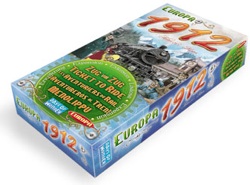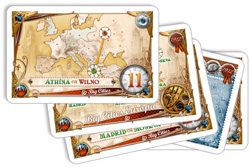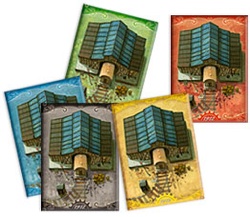by Lee Valentine
 Ticket to Ride: Europa 1912
Ticket to Ride: Europa 1912
(expansion set for Ticket to Ride: Europe)
Published by Days of Wonder
Designed by Alan R. Moon
Contents: 5 Player Warehouses; 25 Wooden Train Depots; 101 Ticket to Ride Europe Destination Tickets, including 55 new and 46 original tickets; full-color rules booklet
$20.00
This game is featured in the OgreCave Christmas Gift Guide 2009
Ticket to Ride: Europa 1912 is a new expansion for the Ticket
to Ride (TTR) series. It is primarily designed, as its name
implies, to work with the European map in the same way that TTR:
1910 worked with the original American map. However, one new
feature that I'll discuss later (the "Warehouses and Depots" feature)
works with all TTR boards.
For those unfamiliar with TTR: Europe, it is a game where players
try to build railroad tracks connecting destinations throughout Europe
(represented by Destination Tickets). Railroad tracks each have a
specific color. Players draw cards from a common deck, and if a player
collects enough Train cards of a given color they can trade them in to
build a corresponding section of track. It is possible to play
aggressively and interrupt someone's track building by laying down
intervening tracks of your own, but in TTR: Europe there are
Train Stations which allow you to continue your journey along a short
stretch of someone else's track.
New Destination Tickets
Europa 1912 comes with lots of new Destination Tickets. First,
you'll find reprinted all 40 original "regular" routes, and all 6
original "long" routes from Ticket to Ride: Europe. Added to
those are 19 new regular routes and 6 more long routes. The 59 total
regular routes can be mixed together and used along with the 12 long
routes for a version of play called "Europe Expanded".
In addition to these cards there are now 30 new cards labeled "Big
Cities". 15 of the original regular routes also bear the "Big Cities"
logo. These 45 cards can be mixed together (setting aside all the other
cards, including the long routes) to play "Big Cities of Europe".
Finally, you can shuffle all the "Big Cities" and all the other regular
routes together, shuffling the 12 long routes separately, and you can
play the "Mega Europe" game with 101 tickets to choose from.
Europe Expanded
Europe Expanded is played by the normal TTR: Europe rules except
that it adds 19 regular route cards and 6 more long routes into the mix.
There are a few strategic differences. It's a little easier to figure
out when you need to block a long route, and a little harder to figure
out which regular routes are being completed. Here's why - first, the
long tickets now have a blue back to distinguish them from regular
routes, meaning that when choosing tickets at the beginning of the game,
people can tell if you kept a long route. For people who memorize the
12 long routes you can easily tell after part of a route is built who
you need to block and where. Second, instead of the long routes all
being 20-21 points, their values now range as low as 16 points. As for
the regular routes, now that there are 19 additional regular routes the
decisions about whether to block and where become a bit more difficult.
Big Cities of Europe
 You might think with the long tickets set aside that the "Big Cities of
Europe" might be a low scoring game, but the values of those tickets go
all the way up to a whopping 25 points. In this version of the game,
each ticket has at least one of 9 different Big Cities on it. Since
players are all trying to connect to similar cities, it's a pretty
cutthroat game, and particularly in a 4-5 player game you can expect to
fail to complete your longer routes, or else you'll be using some train
stations up. This variant of the game, while more competitive,
introduces more luck than is common in TTR: Europe via the ticket
draw mechanic. Because there are a small number of really high scoring
tickets in the Big Cities ticket deck, people who get them and complete
them will have a significant point advantage over their opponents. This
is particularly true because once you have a big ticket completed like
Madrid-to-Moscow in the Big Cities game, when you draw more tickets you
will likely find other shorter overlapping route tickets which you've
already completed. Since every ticket connects (on one end or the
other) to one of 9 cities, drawing extra tickets is a big part of the
Big Cities game.
You might think with the long tickets set aside that the "Big Cities of
Europe" might be a low scoring game, but the values of those tickets go
all the way up to a whopping 25 points. In this version of the game,
each ticket has at least one of 9 different Big Cities on it. Since
players are all trying to connect to similar cities, it's a pretty
cutthroat game, and particularly in a 4-5 player game you can expect to
fail to complete your longer routes, or else you'll be using some train
stations up. This variant of the game, while more competitive,
introduces more luck than is common in TTR: Europe via the ticket
draw mechanic. Because there are a small number of really high scoring
tickets in the Big Cities ticket deck, people who get them and complete
them will have a significant point advantage over their opponents. This
is particularly true because once you have a big ticket completed like
Madrid-to-Moscow in the Big Cities game, when you draw more tickets you
will likely find other shorter overlapping route tickets which you've
already completed. Since every ticket connects (on one end or the
other) to one of 9 cities, drawing extra tickets is a big part of the
Big Cities game.
Mega Europe
The Mega Europe game uses the 12 blue-backed long route tickets and then
a regular route deck composed off all the Europe Expanded and Big Cities
tickets. It features a notable rules difference from normal TTR:
Europe and the Europe Expanded games: here you must draw and decide
whether to keep a long route before you select or even see regular route
tickets. Since Mega Europe features both the blue-backed long route
tickets and the high scoring tickets of the Big City game, you can
expect to play an occasional game with really high scores.
Warehouses & Depots
The new Warehouses and Depots mechanic is the part of Europa 1912
which can be ported to any TTR board. Each player is allotted
five wooden Depots in a color to match their trains and a similarly
color-matched Warehouse card. Players take turns placing just one of
their Depots on the board at the start of the game. During the game,
every time you take the Draw Cards action, you first take the top card
of the Train Deck and put it face down on your Warehouse card without
looking at it. During the game, when a player completes a route that
has a Depot at one end (even if it's of a different color than his own),
he can discard one of his remaining Depots to take all the stored cards
on the matching Warehouse. This could amount to just a few cards, or
you might end up with a dozen cards or more.
 Players can also play more
of their Depots on the board. This is primarily useful for two reasons:
to raid your own Warehouse if you are far away from your originally
placed Depot, or to stop a player from placing a Train Station at a
city, since Stations cannot be placed on a City that has a Depot, and
vice versa. At the end of the game, the player with the most remaining
Depots scores +10 points.
Players can also play more
of their Depots on the board. This is primarily useful for two reasons:
to raid your own Warehouse if you are far away from your originally
placed Depot, or to stop a player from placing a Train Station at a
city, since Stations cannot be placed on a City that has a Depot, and
vice versa. At the end of the game, the player with the most remaining
Depots scores +10 points.
The Warehouses and Depots mechanic adds a new mechanic of skill, luck,
and nerve to the game; it's almost like playing a second game
simultaneously with the first. I found myself humming Cowboy Troy's
song, "I Play Chicken with the Train", as this mechanic pits two
competing values of instant gratification and long-term greed for more
cards against each other. I spent two Depots during one game and drew
over 20 total Train cards as a result.
This is an extremely novel addition to the TTR family of games.
The Warehouses and Depots mechanic is different enough from the base
game that while I wouldn't play with it every time, it is a mechanic
that I would use frequently. I'm not normally a huge fan of playing a
2-player version of TTR: Europe because the Train Station
mechanic waters down blocking, and players can often end up laying down
tracks on totally separate parts of the game board. So, 2-player
TTR: Europe is often a form of multi-player solitaire, and it's
far less cutthroat than the original TTR game (which doesn't have
the Train Stations mechanic). I loved this expansion, because if you
play with the Big Cities cards and particularly if you play with the
Warehouses and Depots, then TTR: Europe becomes a competitive
head-to-head game that plays faster than normal and is loaded with
dramatic tension.
Rulebook & Components
Like many Days of Wonder rulebooks, the rulebook for TTR: Europa
1912 repeats the rules several times in different languages,
including English, German, French, Spanish, Dutch, Danish, Norwegian,
Swedish, and Finnish. The rules are simple and mostly straightforward,
and I had few problems adapting to the game variants. It wasn't
completely obvious to me that I needed to transport a select number of
cards back and forth between the Europe Expanded and Big Cities
Destination Ticket decks prior to changing between those games.
All the cards in this expansion feature a custom 1912 deck back. The
graphic design of the cards is largely similar to the tickets found in
the base game, except for a 1912 logo to mark the new cards from the
expansion and a special "Big Cities" banner on some of the cards.
The Depots are made of painted wood. The Warehouse cards have
full-color art printed on glossy stock. The cardstock used for the
Warehouses is a bit light, but that's OK, because the Warehouses are not
handled often and generally just sit on the game table.
Conclusions
If you don't own Ticket to Ride: Europe then I am not certain as
to whether I would recommend you spend $20.00 on buying this expansion
just for the Warehouses and Depots pieces. However, if you already own
TTR: Europe, this is a fantastic expansion for the game. It
makes the base game more versatile and really makes TTR: Europe
viable in 2-player play. I strongly recommend this to people who
already own TTR: Europe.
For Retailers
Ticket to Ride has a great fan following. While expansions don't
sell as well as base games in general, the price point is right on this
product. If Ticket to Ride: 1910 or Ticket to Ride:
Europe moved well in your store then expect Ticket to Ride:
Europa 1912 to do well for you. If you hand sell this product,
focus on the Warehouses and Depots mechanic, as it is unique to this
product, and it really brings something new to Ticket to Ride
games.
Lee's Ratings
Overall: A-
Game Play: A-
Components: A- (slightly thin Warehouse cards, but otherwise great production value)
Rules: B+
Retailer Salability: B
| Related reviews on OgreCave: |
|
|


 Ticket to Ride: Europa 1912
Ticket to Ride: Europa 1912 You might think with the long tickets set aside that the "Big Cities of
Europe" might be a low scoring game, but the values of those tickets go
all the way up to a whopping 25 points. In this version of the game,
each ticket has at least one of 9 different Big Cities on it. Since
players are all trying to connect to similar cities, it's a pretty
cutthroat game, and particularly in a 4-5 player game you can expect to
fail to complete your longer routes, or else you'll be using some train
stations up. This variant of the game, while more competitive,
introduces more luck than is common in TTR: Europe via the ticket
draw mechanic. Because there are a small number of really high scoring
tickets in the Big Cities ticket deck, people who get them and complete
them will have a significant point advantage over their opponents. This
is particularly true because once you have a big ticket completed like
Madrid-to-Moscow in the Big Cities game, when you draw more tickets you
will likely find other shorter overlapping route tickets which you've
already completed. Since every ticket connects (on one end or the
other) to one of 9 cities, drawing extra tickets is a big part of the
Big Cities game.
You might think with the long tickets set aside that the "Big Cities of
Europe" might be a low scoring game, but the values of those tickets go
all the way up to a whopping 25 points. In this version of the game,
each ticket has at least one of 9 different Big Cities on it. Since
players are all trying to connect to similar cities, it's a pretty
cutthroat game, and particularly in a 4-5 player game you can expect to
fail to complete your longer routes, or else you'll be using some train
stations up. This variant of the game, while more competitive,
introduces more luck than is common in TTR: Europe via the ticket
draw mechanic. Because there are a small number of really high scoring
tickets in the Big Cities ticket deck, people who get them and complete
them will have a significant point advantage over their opponents. This
is particularly true because once you have a big ticket completed like
Madrid-to-Moscow in the Big Cities game, when you draw more tickets you
will likely find other shorter overlapping route tickets which you've
already completed. Since every ticket connects (on one end or the
other) to one of 9 cities, drawing extra tickets is a big part of the
Big Cities game.
 Players can also play more
of their Depots on the board. This is primarily useful for two reasons:
to raid your own Warehouse if you are far away from your originally
placed Depot, or to stop a player from placing a Train Station at a
city, since Stations cannot be placed on a City that has a Depot, and
vice versa. At the end of the game, the player with the most remaining
Depots scores +10 points.
Players can also play more
of their Depots on the board. This is primarily useful for two reasons:
to raid your own Warehouse if you are far away from your originally
placed Depot, or to stop a player from placing a Train Station at a
city, since Stations cannot be placed on a City that has a Depot, and
vice versa. At the end of the game, the player with the most remaining
Depots scores +10 points.